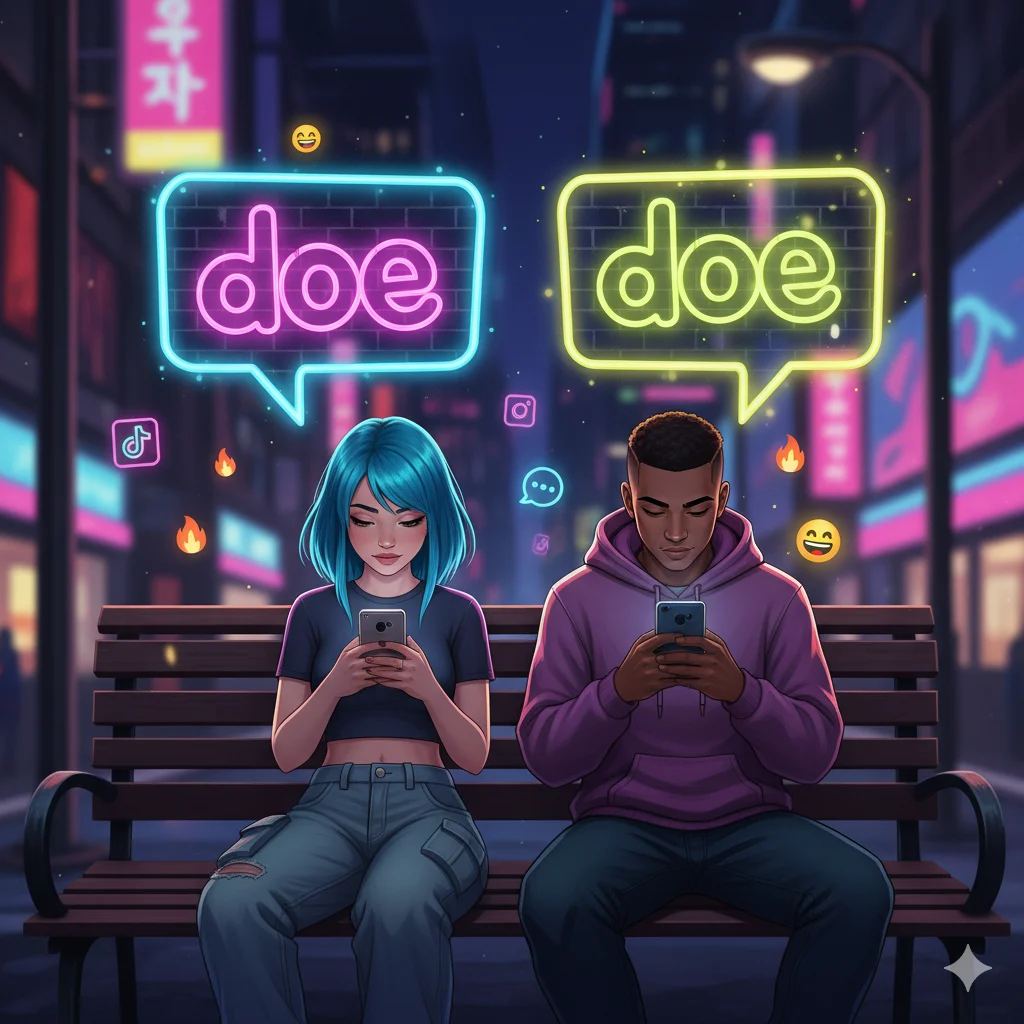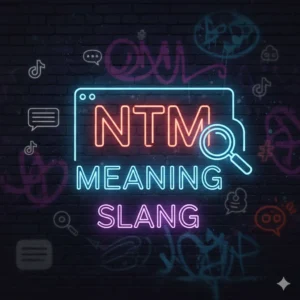In the ever-changing world of internet slang, new words and abbreviations appear faster than we can keep up. One such word that often leaves people confused is “doe.” You might’ve seen it in memes, comments, or text messages like, “She funny, doe,” or “That’s crazy, doe!”
While it looks like a typo, “doe” actually plays a big role in how people — especially Gen Z and millennials — talk online. It’s casual, expressive, and adds personality to any sentence.
In this article, we’ll explore the meaning of “doe” in slang, how it’s used in conversations, where it came from, and why it’s become such a viral part of digital communication.
What Does “Doe” Mean in Slang?
At its simplest, “doe” is just a slang or phonetic spelling of the word “though.” People use it at the end of sentences or phrases to emphasize contrast, emotion, or humor.
For example:
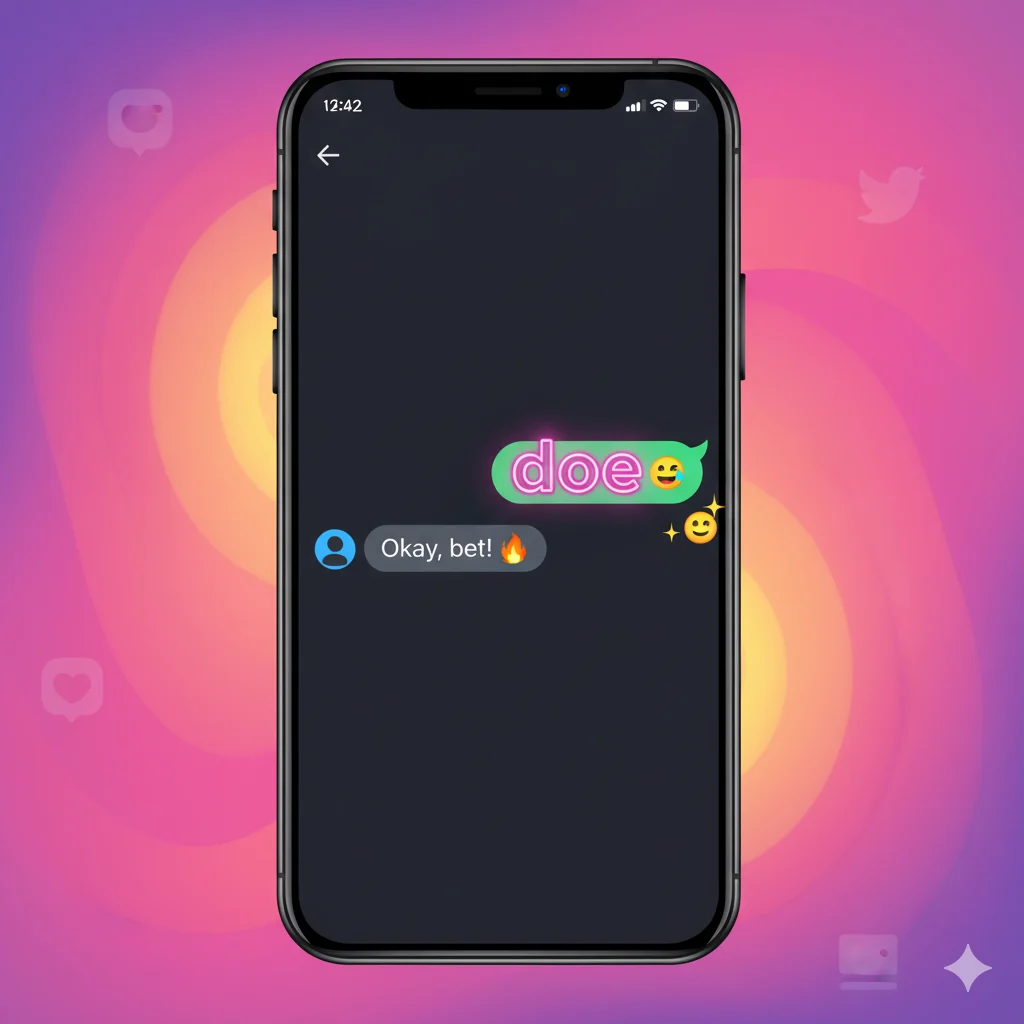
- “That outfit is fire, doe!” → means “That outfit is amazing, though!”
- “He annoying, doe.” → means “He’s annoying, but still…”
It’s all about tone and flow. Instead of sounding serious, “doe” keeps the sentence relaxed and relatable. It gives a playful or emotional twist to everyday statements — something that fits perfectly in text messages, tweets, and memes.
The Origin of “Doe” Slang
The slang “doe” comes from phonetic spelling in African American Vernacular English (AAVE), where pronunciation often drops or shifts certain sounds.
When people in casual speech pronounced “though” as “doe,” it naturally transitioned into written internet slang. With the rise of social media platforms like Twitter, Tumblr, and TikTok, users began to write the word as they spoke, and “doe” became a normal part of online conversation.
Later, memes and viral tweets helped it spread globally. People began using it humorously — not as poor spelling, but as part of internet culture.
How “Doe” Is Used in Texts and Social Media
“Doe” is one of those slang words that can fit almost anywhere in a sentence, but it usually appears at the end for emphasis.
Here’s how it works in real examples:
- “She mad, doe 😭” → expressing humor about someone being upset.
- “You right, doe.” → showing agreement or realization.
- “He broke, doe 💀” → teasing or jokingly pointing out something ironic.
- “That new song go hard, doe 🔥” → showing excitement or approval.
The tone can change depending on emojis, context, or capitalization. For instance:
- “DOEEEEE” = high excitement or exaggeration.
- “doe.” = calm or low-key shade.
It’s versatile, fun, and can completely change how a message feels.
“Doe” vs “Though”: What’s the Difference?
Grammatically, “though” is the correct word — but slang isn’t about grammar, it’s about style and tone.
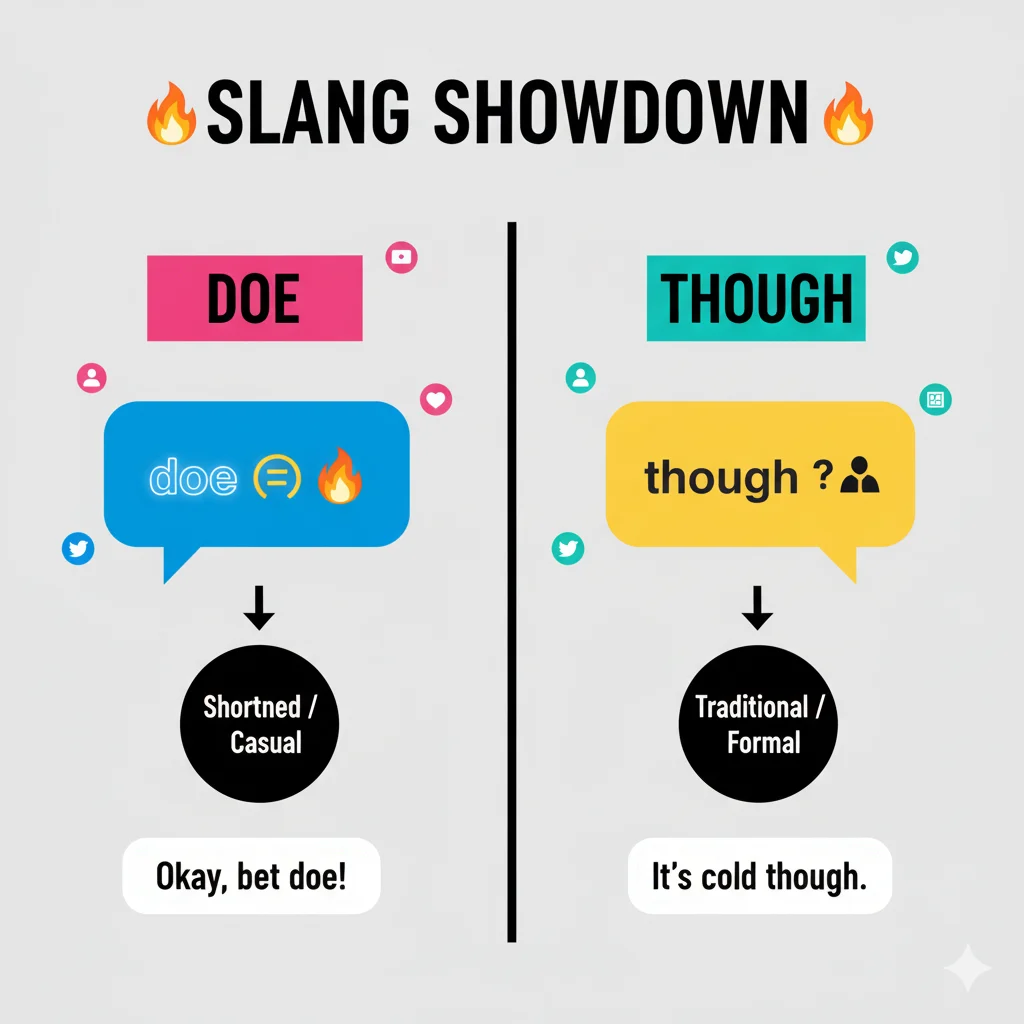
| Aspect | “Though” | “Doe” |
|---|---|---|
| Formality | Proper English | Informal slang |
| Tone | Neutral or serious | Playful or expressive |
| Use | Writing, essays, formal talk | Texts, memes, social media |
| Audience | General | Mostly Gen Z & Millennials |
Essentially, “doe” is how “though” feels when spoken in relaxed, expressive conversation. It’s casual and filled with attitude — the kind that dominates social platforms like TikTok or X (Twitter).
“Doe” in Memes and Pop Culture
The word “doe” found massive popularity through memes and viral trends. You’ll often see it paired with humor, irony, or dramatic reactions.
For example:
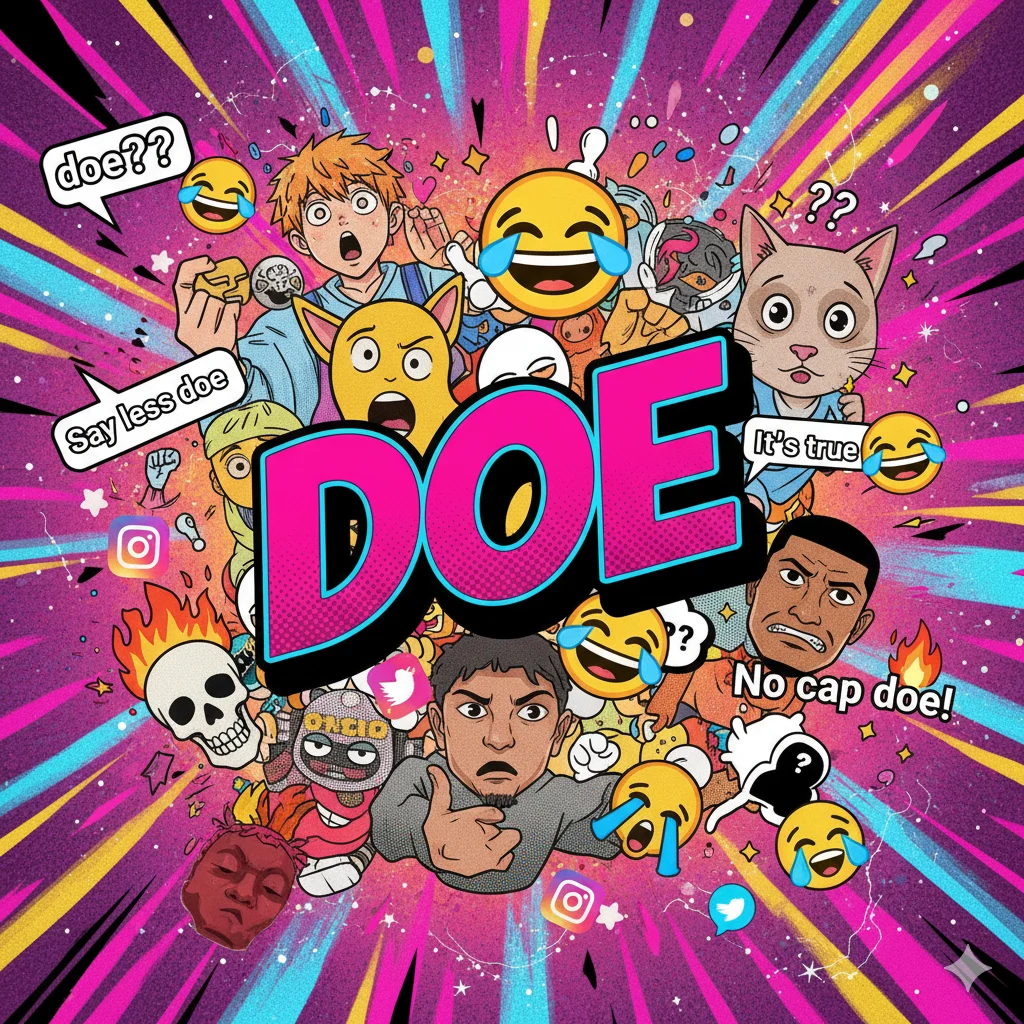
- A meme might show a cat with a funny face captioned: “He cute, doe.”
- Or a TikTok might end with the caption: “She said it was just dinner, doe 👀.”
In meme culture, “doe” emphasizes a punchline — it turns ordinary statements into something funny or exaggerated.
Even music and influencers use it. Many rap lyrics or viral tweets adopt this casual spelling to stay relatable and conversational.
Why People Use “Doe” Instead of “Though”
There’s a cultural rhythm behind slang like “doe.” It’s more than just shortening words — it’s about personality, tone, and authenticity.
Here’s why “doe” works so well:
- It’s conversational: It sounds like how people actually talk.
- It adds flavor: Makes a sentence sound cooler or funnier.
- It softens tone: Makes messages feel friendly, not formal.
- It signals community: Using slang shows you’re part of modern internet culture.
In other words, “doe” isn’t lazy English — it’s emotional shorthand.
Common Contexts Where “Doe” Appears
You’ll find “doe” popping up in:
- Funny tweets or memes: “He said it’s a friendship hug, doe 😭”
- TikTok captions: “This filter scary, doe 😭🔥”
- Text messages: “U look tired, doe.”
- Song lyrics or rap lines: “Got no time for sleep, money calling, doe.”
Its adaptability makes it one of the most used informal slang terms across different communities and age groups.
Other Meanings of “DOE”
While slang “doe” means though, the acronym “DOE” can mean completely different things depending on context:
- DOE (Department of Energy): Government organization in the U.S.
- DOE (Depending On Experience): Used in job listings to describe salary negotiation.
- Doe (Female Deer): A literal animal term, not slang, but often confused.
So remember: in lowercase (“doe”), it’s slang; in uppercase (“DOE”), it’s usually an acronym.
The Role of “Doe” in Digital Communication
The rise of “doe” reflects how language evolves online. It shows:
- Creativity in expression
- Cultural diversity influencing speech
- How informal tones dominate digital communication
Modern slang like “doe” keeps online spaces expressive, fun, and relatable. It bridges tone and personality in ways that formal writing simply can’t.
How to Use “Doe” Naturally
Here are quick tips to use “doe” like a pro:
- Keep it casual. It’s not for essays or business emails.
- Use it at the end of sentences. That’s the natural rhythm.
- Add emojis or tone indicators. They enhance the humor or attitude.
- Avoid overusing it. Too much can make messages hard to read.
- Match the vibe. Use it when the conversation is lighthearted or playful.
Example sentences:
- “You ate that, doe 🔥.”
- “She talkin’ loud, doe 💀.”
- “That food bussin’, doe 😭.”
The Psychology Behind “Doe” Slang
Slang like “doe” helps people connect emotionally. It reduces formality and creates a sense of friendship and belonging.
When people use relaxed language online, they:
- Feel more authentic.
- Mirror real-life speech.
- Build social closeness.
“Doe” adds humor, warmth, or even light sarcasm — all key traits of internet communication today.
Why “Doe” Has Staying Power
Unlike some slang that fades quickly, “doe” has stuck around for over a decade because it’s easy, versatile, and rhythmic. It fits naturally into speech and writing, so even when trends shift, “doe” remains part of online vocabulary.
Its survival shows how simple expressions can gain cultural weight — turning something as ordinary as “though” into a digital emotion marker.
Examples of “Doe” in Real Conversations
Here are some real-life examples of how people use “doe” in everyday texting:
- “That movie was long, doe.”
- “I’m broke, doe, can’t go out tonight 😭.”
- “She kinda right, doe.”
- “Bro said he done with drama, doe 😂.”
- “This filter wild, doe!”
Each of these shows a mix of humor, attitude, or honesty — exactly what gives “doe” its power.
FAQs About “Doe” Slang
Q1: What does “doe” mean in texting?
It means “though,” used to emphasize or add humor at the end of a sentence.
Q2: Is “doe” bad grammar?
Technically yes, but in slang and digital communication, it’s widely accepted as casual speech.
Q3: Where did “doe” slang start?
It originated from African American Vernacular English (AAVE) and became popular online through memes and social media.
Q4: Does “doe” mean “money”?
Sometimes, “doe” (pronounced the same) can mean “money,” but that’s a completely different slang term — not related to “though.”
Q5: Is “doe” still popular in 2025?
Yes! “Doe” remains part of Gen Z texting culture, used humorously in chats, memes, and TikTok videos.
Conclusion: A Little Word with Big Vibe
The slang word “doe” might look small, but it carries a lot of meaning. It’s casual, expressive, and filled with personality — a perfect example of how online culture reshapes language.
From AAVE roots to global meme fame, “doe” shows how words evolve, travel, and connect people. Whether you use it in jokes, captions, or DMs, it’s more than slang — it’s digital attitude in three simple letters.
So next time someone texts, “That’s true, doe,” remember: they’re not just saying “though.” They’re saying it with style.


